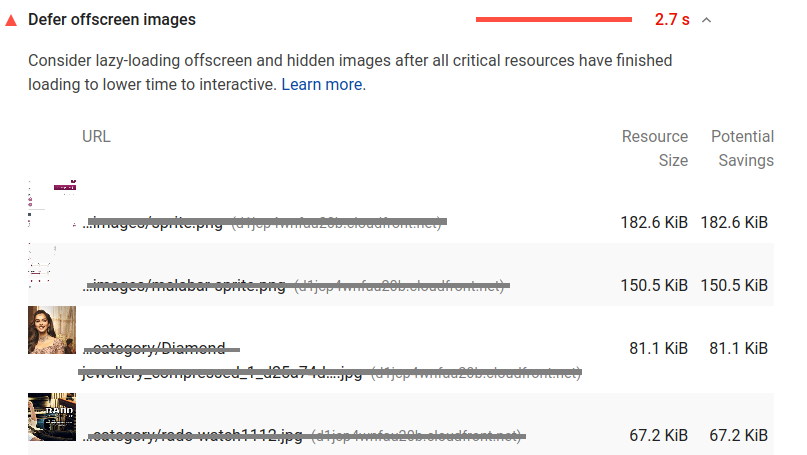SEO Impact of Lazy Loading Images
How lazy-loading images can potentially affect SEO & how to keep lazy-loading of images SEO friendly.
Jul 23, 2020
SEO Impact of Lazy Loading Images
How lazy-loading images can potentially affect SEO & how to keep lazy-loading of images SEO friendly.
Jul 23, 2020

Google's push for Website Speed
Google has been evangelizing website speed for years. Over the years, it has released many tools & articles to help website owners improve their site speed. A common speed improvement Google suggests is to delay loading off-screen images. More commonly, this is referred to as lazy-loading images. This is an easy-to-perform change with notable gains since images are commonly biggest chunk of a web page's size.
Site speed: A ranking factor for mobile SEO
Google is very secretive about the factors affecting search rankings. But, when it comes to site-speed, Google has publicly stated that site speed is a ranking factor for mobile search. This makes it vital for sites to load fast on mobile devices.
Approaches for lazy loading images
As of July, 2020 - there are two possible approaches to lazy-load images:
Native Lazy Loading
Native lazy loading is the most elegant solution to lazy-load images. All it requires is to add loading=lazy attribute to an image that you want to lazy load. So, your lazy-loaded HTML code looks like <img src="url" loading="lazy" />. The only downside to this solution is that (as of July-2020) it works only recent versions of Chrome & Firefox (see here). This means that images on other browsers shall be displayed but not lazy-loaded.
JavaScript based lazy loading
The second approach to lazy-load images is to use JavaScript to load images. Many libraries & plugins are available to do this. These solutions often look like following:
<!--HTML code that avoids loading image right-away-->
<img class="lazyImg" data-src="myImg.jpg" src="SmallPlaceholderImg.jpg">
<script>
//Some JavaScript code that would load the image at the right time
</script>
In the above (representative) example, we avoid letting HTML load the image. Instead, we control it through JavaScript which can be fired when user scrolls to a section of the page. Benefit of the solution like the one above is that it is cross-browser compatible.
Googlebot indexing & JavaScript driven content
This has been a long-existing worry in the minds of digital marketers: does Googlebot execute on-page JavaScript? Because, if it doesn't - content driven by JavaScript (like our lazy-loaded images) may not be indexed at all.
First up - Google has confirmed that Googlebot uses an evergreen version of Chrome (source). Also - Google has confirmed that the Googlebot does execute on-page JavaScript to render content (source).
However, it is important to consider the following points:
So, while Googlebot will execute JavaScript & render JavaScript driven content, we need to be really careful to follow the good-practices here.
Potential down-sides of image non-indexing
Let us, for a moment, assume that the images on our website aren't indexed (due to any reason). This can negatively affect SEO in two ways:
From the above points - if images are central to your web pages' content - missing on their indexing can dent your search engine rankings notably. This demands care with regard to keeping images SEO friendly.
SEO friendly & cross-browser compatible image lazy-loading
So, is there an ideal solution that lets us lazy-load images and deal with all the limitations we enlisted above? Well, yes. Let's look at representative code snippet below (note - the snippet is representative and not directly usable):
<!--HTML code that avoids loading image right-away-->
<img class="lazyImg" data-src="myImg.jpg" src="placeholderImg.jpg">
<script>
//Some JavaScript code that would load the image at the right time
</script>
<!--noscript for non-javascript rqeuests -->
<noscript><img src="myImg.jpg" /></noscript>
The key specific in the (representative) snippet above is the use of <noscript>. It ensures that our image is picked for indexing even if on-page JavaScript isn't executed for page-rendering. This makes our solution SEO friendly and gives us complete control to lazy-load images. Our recommended JavaScript library for safe lazy-loading of images is lazysizes - it leverages IntersectionObserver to lazy-load images. This how-to covers how to setup SEO friendly lazy-loading of images using lazysizes.
Conclusion
Image lazy-loading often requires the power of JavaScript to control when you may load an image. As a result, it is critical to keep lazy-loading SEO friendly. This can be best achieved via use of:
<noscript> - to load images when JavaScript isn't executed.IntersectionObserverAlso Read

